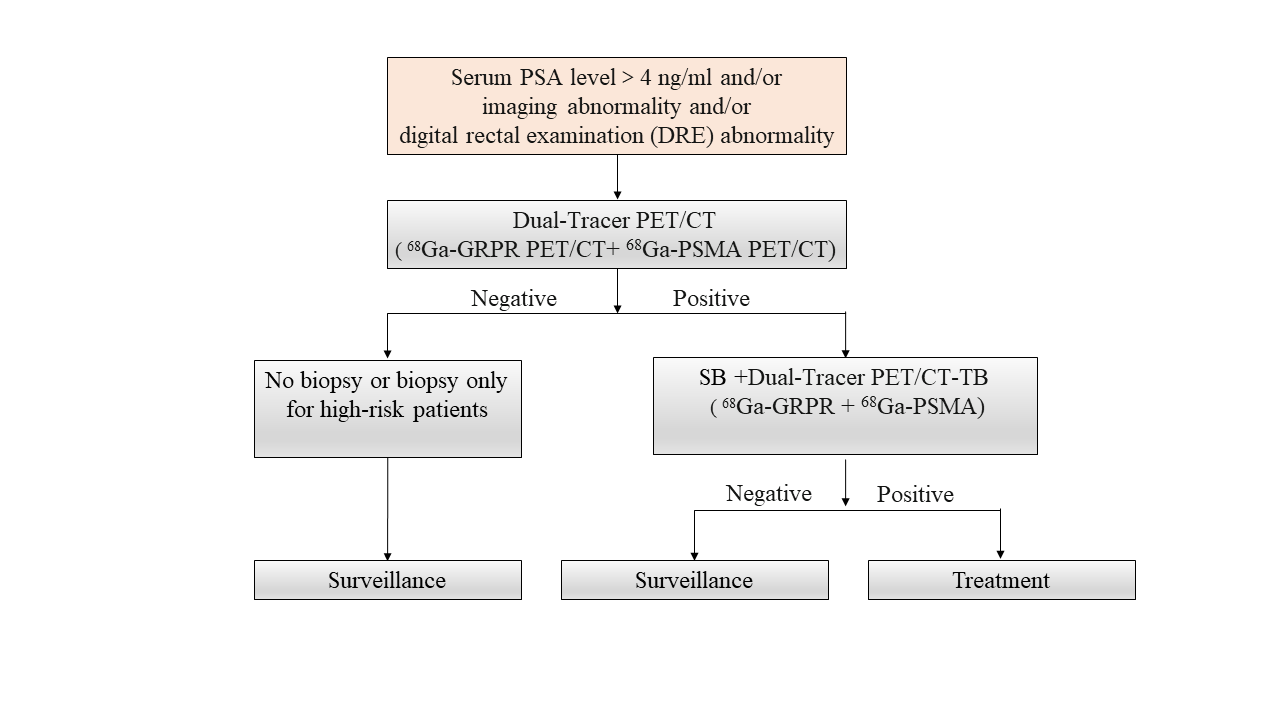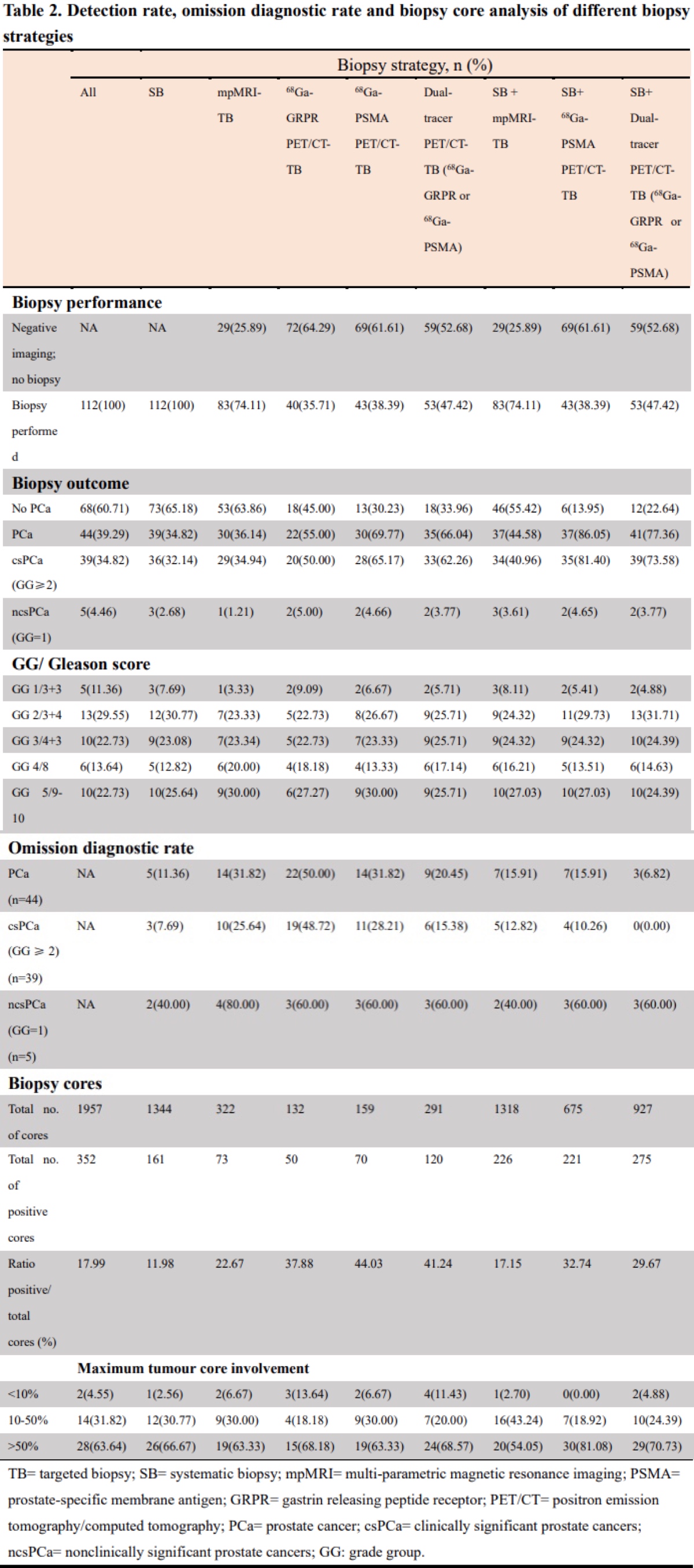Back
Poster, Podium & Video Sessions
Podium
PD57: Prostate Cancer: Detection & Screening VI
PD57-12: Dual-Tracer PET/CT-Targeted, mpMRI-Targeted,Systematic Biopsy, and Combined Biopsy for the Diagnosis of Prostate Cancer
Monday, May 16, 2022
11:20 AM – 11:30 AM
Location: Room 245
Dongxu Qiu, Jian Li, Jinwei Zhang, Minfeng Chen, Xiaomei Gao, Yongxiang Tang, Ye Zhang, Xiaoping Yi, Hongling Yin, Yu Gan, Guilin Wang, Xiongbing Zu, Shuo Hu, Yi Cai*, Changsha, China, People's Republic of
- YC
Podium Presenter(s)
Introduction: Growing evidence proved the efficacy of multiparametric MRI (mpMRI) and prostate-specific membrane antigen (PSMA) positron emission tomography/computed tomography (PET/CT)-guided targeted biopsy (TB) in prostate cancer (PCa) diagnosis, but there is no direct comparison between mpMRI-TB and PSMA PET/CT-TB. Gastrin-releasing peptide receptor (GRPR) highly expressed in PCa, which can compensate for the unstable expression of PSMA in PCa. Therefore, we designed a study to compare the efficiency of mpMRI-TB, dual-Tracer (GRPR and PSMA) PET/CT-TB, systematic biopsy, and combined biopsy for the diagnosis of prostate cancer.
Methods: 112 suspicious PCa patients were enrolled from September 2020 and June 2021 in this prospective and comparative effectiveness study. Patients with positive dual-tracer PET/CT or mpMRI results underwent TB and all enrolled patients underwent SB after TB. The primary outcome was the detection rates of PCa in different biopsy strategies. Secondary outcomes were the performance of three imaging methods, omission diagnostic rates, and upgrading and downgrading of biopsy samples relative to those of prostatectomy specimens in different biopsy strategies.
Results: In 112 men, clinically significant PCa (grade group=2) accounted for 34.82% (39/112) and nonclinically significant PCa (grade group =1) accounted for 4.46% (5/112). 68Ga-PSMA PET/CT-TB achieved higher PCa detection rate (69.77%) and positive ratio of biopsy cores (0.44) compared with SB (39.29% and 0.12) and mpMRI-TB (36.14% and 0.23), respectively (P <0.005). Dual-tracer PET/CT as a triage test avoided 52.67% (59/112) unnecessary biopsy, whereas dual-tracer PET/CT-TB plus SB achieved high detection rate (77.36%) without misdiagnosis of csPCa.
Conclusions: Dual-tracer PET/CT could screen patients for avoiding unnecessary biopsy. Dual-tracer PET/CT-TB plus SB might be a more effective and promising strategy for definite diagnosis of clinically significant PCa than mpMRI-TB.
Source of Funding: This investigation was sponsored by the key Research and Development program of Hunan Province (2021SK2014), the National Natural Science Foundation of China (91859207), the National Natural Science Foundation of China (81800590, 81902858, 81902606), and Natural Science Foundation of Hunan Province (2020JJ5882, 2020JJ5949, 2020JJ5891).


Methods: 112 suspicious PCa patients were enrolled from September 2020 and June 2021 in this prospective and comparative effectiveness study. Patients with positive dual-tracer PET/CT or mpMRI results underwent TB and all enrolled patients underwent SB after TB. The primary outcome was the detection rates of PCa in different biopsy strategies. Secondary outcomes were the performance of three imaging methods, omission diagnostic rates, and upgrading and downgrading of biopsy samples relative to those of prostatectomy specimens in different biopsy strategies.
Results: In 112 men, clinically significant PCa (grade group=2) accounted for 34.82% (39/112) and nonclinically significant PCa (grade group =1) accounted for 4.46% (5/112). 68Ga-PSMA PET/CT-TB achieved higher PCa detection rate (69.77%) and positive ratio of biopsy cores (0.44) compared with SB (39.29% and 0.12) and mpMRI-TB (36.14% and 0.23), respectively (P <0.005). Dual-tracer PET/CT as a triage test avoided 52.67% (59/112) unnecessary biopsy, whereas dual-tracer PET/CT-TB plus SB achieved high detection rate (77.36%) without misdiagnosis of csPCa.
Conclusions: Dual-tracer PET/CT could screen patients for avoiding unnecessary biopsy. Dual-tracer PET/CT-TB plus SB might be a more effective and promising strategy for definite diagnosis of clinically significant PCa than mpMRI-TB.
Source of Funding: This investigation was sponsored by the key Research and Development program of Hunan Province (2021SK2014), the National Natural Science Foundation of China (91859207), the National Natural Science Foundation of China (81800590, 81902858, 81902606), and Natural Science Foundation of Hunan Province (2020JJ5882, 2020JJ5949, 2020JJ5891).



.jpg)
.jpg)